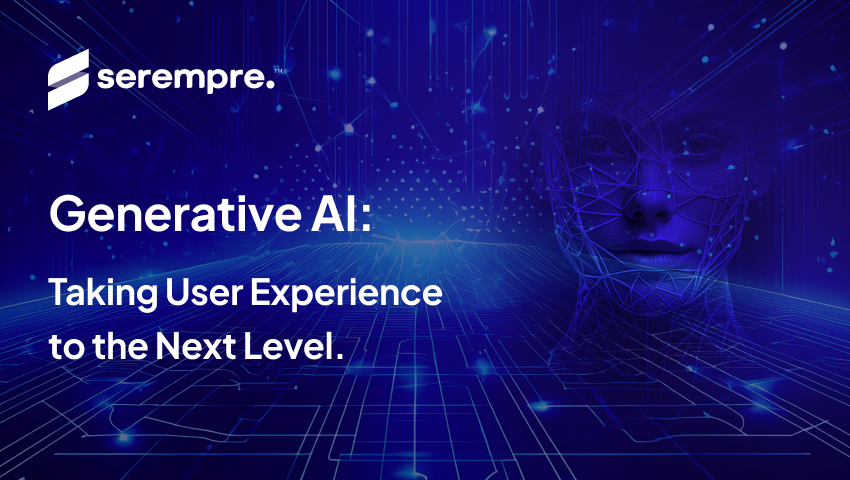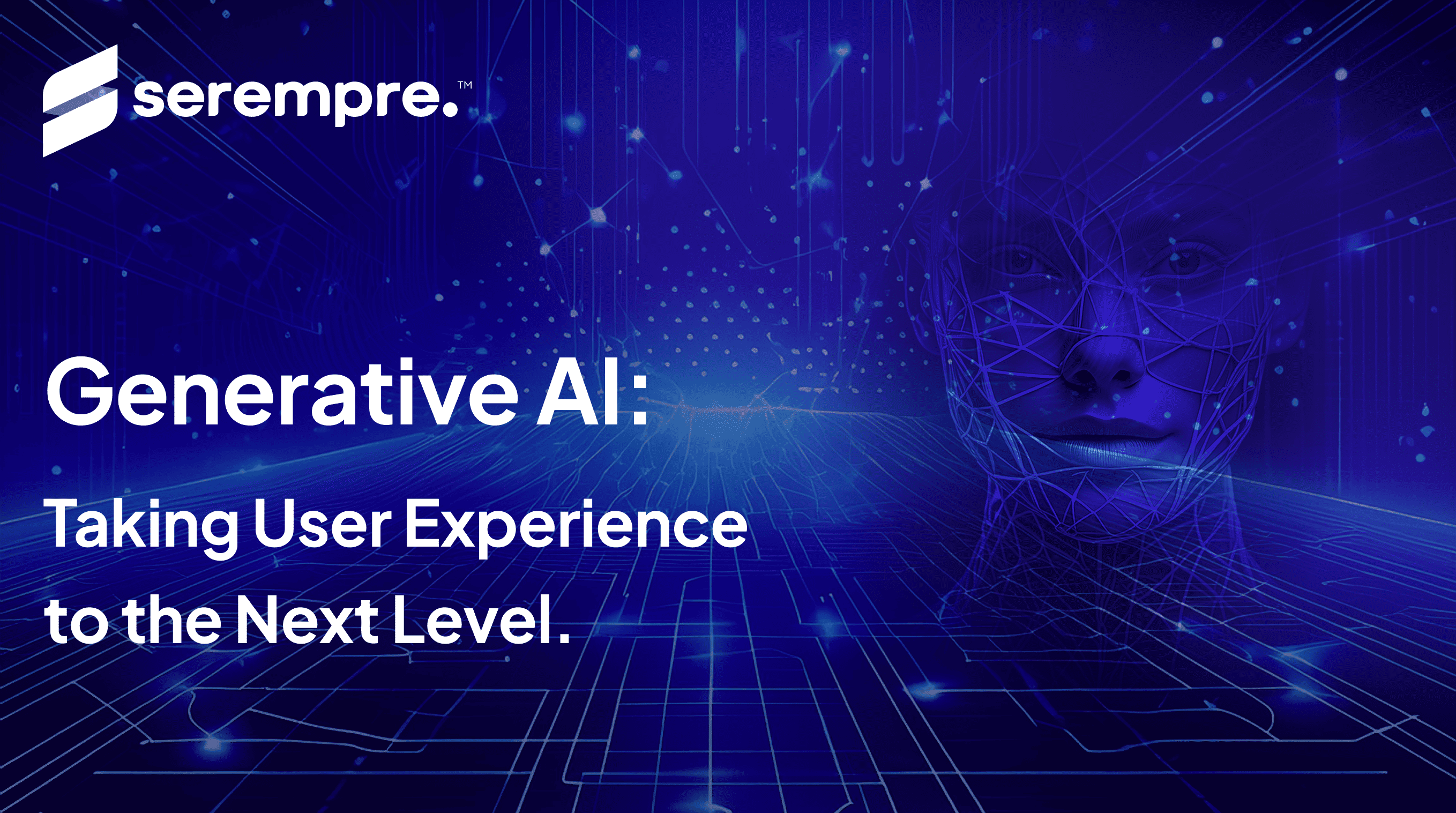
Generative Artificial Intelligence (AI) is profoundly transforming the way users interact with digital technologies. From the proliferation of advanced AI-powered tools to the creation of highly personalized user experiences (UX), this technology heralds a new era in experience design. For instance, according to PwC, by November 2023, 54% of companies had already integrated generative AI into their operations. In this edition of the Serempre Blog, we explore how generative AI is redefining UX and the opportunities it presents for customer-centric businesses.
The Evolution of Generative AI and User Experience
Generative AI has been around longer than we might imagine. Many trace its origins back to “Eliza,” widely considered the first chatbot in history. Eliza aimed to simulate a conversation with a therapist, generating responses based on keywords in user input using a simple algorithm. Since then, generative AI has evolved through numerous technological advancements, such as the emergence of neural networks in the 1980s, the launch of voice assistants like Siri, and the development of Generative Adversarial Networks (GANs) for data generation from training datasets.
In the 2020s, generative AI experienced exponential growth with the launch of ChatGPT. This breakthrough accelerated generative AI development and inspired new solutions like Stable Diffusion, MidJourney, Bard, and even search engines like Bing integrating ChatGPT technology. According to Gartner, as of October 2023, 55% of organizations were either experimenting with or implementing generative AI solutions.
Generative AI enables a UX that transcends the predictive approach of traditional AI. While traditional AI optimizes processes through pattern and structured data analysis, generative AI drives large-scale content creation and personalization, offering immersive and adaptive interactions. Companies can now anticipate and adjust to user expectations in real time, significantly enhancing the relevance of interfaces and user experiences.
Generative AI’s Impact on UX
As mentioned, generative AI continues to grow, with projections suggesting a compound annual growth rate of 24.4% through 2030. This growth is transforming UX through capabilities like advanced personalization, adaptive interfaces, and conversational experiences. Let’s explore some key areas where this technology adds value.
Deep Personalization Driven by Data
Thanks to AI, companies can analyze complex patterns and create content tailored to individual user preferences, boosting satisfaction and engagement. Technologies like machine learning and deep learning enable the collection of vast interaction data to fuel models that generate unique content suited to each user’s profile. From product design to marketing, generative AI is personalizing every aspect of UX.
For instance, in product development, generative AI adds value by optimizing design concepts, synthesizing user feedback, and automating routine processes. In marketing, AI is used to craft multichannel campaigns tailored to users. Consumer brands leverage AI to create immersive digital campaigns that include generative models, enabling users to interact with technology in innovative ways. In creative fields like design, generative AI produces texts, images, animations, and videos for interface designs. These examples illustrate the myriad use cases of personalization through generative AI.
Adaptive Interfaces
Generative AI leverages data, preferences, and behavioral patterns to empower interface designers. It enables the creation of interfaces that dynamically adapt to user preferences, optimizing navigation and usability. Data collected is used to automatically adjust interface structures, personalizing not just content but also layout and visual elements, enhancing user interaction and retention.
Examples include eCommerce platforms that employ generative AI to automate product description design, optimize visual presentation, and adapt language to consumer profiles using machine learning models. Tools like Phrasee, a natural language generation platform, learn and replicate each client’s tone of voice, demonstrating the potential of generative AI in improving UX.
Next-Level Conversational Experiences
Generative AI’s ability to produce diverse content formats has revolutionized conversational experiences in sectors like customer service. Combining generative AI with conversational models allows companies to overcome industry challenges like availability issues, enhance response accuracy, and provide 24/7 interactions. Personalization of response flows enables conversational agents to adapt to the tone and context of each query, delivering tailored services.
Businesses implementing AI in customer service achieve greater efficiency through capabilities like constant availability, real-time conversational analysis, and continuous improvement based on interaction data. This technology creates adaptive services for multiple channels such as WhatsApp, Instagram, websites, and more, significantly optimizing user experience.
Immersive Marketing and Advertising Experiences
Marketing and advertising have experienced a profound impact from generative AI, creating hyper-personalized content that captures and retains user attention. From auto-generating images to crafting advertising copy, generative AI enables visually compelling campaigns aligned with consumer expectations and desires.
Brands like Coca-Cola and Heinz exemplify this transformation. Coca-Cola’s “Create Real Magic” campaign combines ChatGPT and DALL-E to allow users to generate custom visual art based on Coca-Cola’s branding. Heinz leveraged generative AI (DALL-E) to produce ketchup-themed images for its “Heinz A.I. Ketchup” campaign. These immersive experiences foster emotional connections with the brand, illustrating the potential of AI-enhanced marketing.
Challenges in Generative AI Implementation
Despite its advancements, implementing generative AI in UX presents critical challenges that must be addressed. Below are some of the challenges facing the adoption of AI and its various branches:
- - According to a 2023 OpenAI article, 80% of U.S. workers could see at least 10% of their tasks affected, with 19% facing over half of their work impacted.
- - Statista reports that AI adoption will require at least 20% of employees to retrain.
- - According to Mitre, 52% of U.S. employees worry AI could replace their jobs. Additionally, 81% of adults believe the industry should invest more in AI safety guarantees, and 85% want transparent practices before launching AI products.
- - Mitre also notes that only 39% of U.S. adults consider current AI technology safe.
- - Mckinsey reports that 56% of companies cite "inaccuracy" as the greatest risk in generative AI adoption.
- - Deloitte states that 56% of executives are unsure if their organizations have ethical standards guiding generative AI use.
- - IBM reveals that only 40% of people trust companies to use new technologies like AI ethically, while three out of four executives view ethics as a competitive differentiator.
These challenges extend beyond UX processes, affecting technology adoption, solution effectiveness, and organizational readiness. Additional obstacles include the lack of skilled personnel, technical challenges like data quality and availability, algorithmic bias from prejudiced data, model decision explainability, and more. Issues like solution scalability, infrastructure costs, and real-time performance can directly influence UX.
To address these challenges, companies must adopt robust cultural change strategies, invest in expert talent, and develop ethical frameworks ensuring the effectiveness and scalability of generative AI solutions. Fostering a culture of innovation, designing user-centered solutions, and more will significantly impact solution effectiveness and ROI.
Success Stories of Generative AI in UX
As explored, generative AI has been reshaping UX by generating user-driven content. Some notable use cases demonstrate how this technology elevates UX across various sectors:
Heinz - Images Generated with Generative AI
The renowned ketchup brand Heinz leveraged generative AI to make one of its marketing and advertising campaigns more appealing and engaging for its users. For its campaign “Heinz A.I. Ketchup,” the brand tasked the generative AI (DALL-E) with creating ketchup imagery, which was then adapted to fit the Heinz brand.
Coca - Cola “Create Real Magic”
This Coca-Cola initiative is a clear example of how generative AI is enhancing marketing and user experience campaigns. The campaign features a creative Coca-Cola portal that integrates ChatGPT and DALL-E, allowing users to generate custom visual art based on Coca-Cola's branding elements. Creators can register on the Coca-Cola Create Real Magic portal to generate images using text prompts powered by generative AI. Coca-Cola then stores these creations in its creative gallery. This immersive experience strengthens the connection with the brand, enabling users to become co-creators of content.
Amazon Connect
Amazon Connect is Amazon and AWS’s AI-powered contact center. This platform uses generative AI to create conversational flows and user-specific responses, offering personalized services for every customer. Additionally, the contact center leverages AI for conversational analysis, service optimization, user experience analytics, and more. Companies like Capital One, Origin, Square, Subway, Adobe, Siemens, and others are examples of how generative AI is transforming customer service into an efficient and innovative experience.
Tribute to the Cali Fair
A well-known beverage brand created an immersive experience to honor the Cali Fair, one of Colombia’s most significant cultural festivals. This solution featured a portal where attendees of the Cali Fair could generate festival-related images simply by providing the portal with a few instructions. This is a prime example of using text and image generation to create an interactive and immersive user experience, rarely seen before.
Poker Parche Low Cost
The renowned beer brand Poker created an immersive experience for its users called "Parche Low Cost." This experience featured a response generator that allowed users to interact with an Intelligent Chef, which provided budget-friendly recipe recommendations based on ingredients and instructions given by the user via the chatbot. This is another excellent example of how a simple response generator can be transformed into a personalized campaign for every user.
Generative AI is still in the early stages of its development, but its potential is undeniable. In fact, Gartner predicts that by 2027, over 50% of generative AI models used by businesses will be tailored to specific industries or departments, up from just 1% in 2023. This will further transform the user experience. In the near future, we can expect generative AI to create solutions that are even more personalized for users, with enhanced data collection and analysis capabilities. Ready to unlock the potential of this and other technologies for your business? Contact us!


